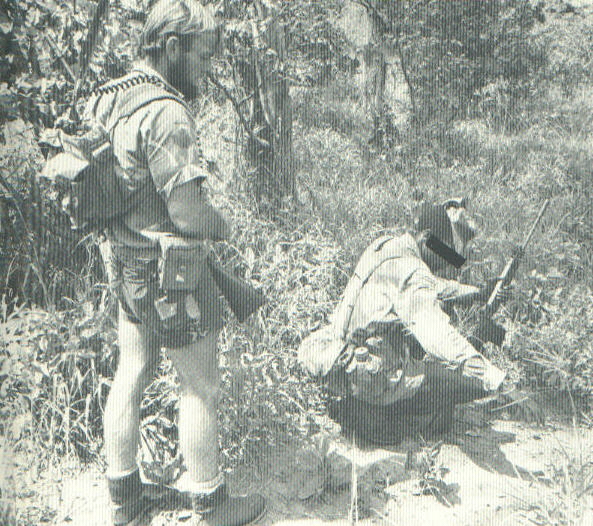|
ADVANCE
TRACKING TECHNIQUES

Tracking involves more than just following a string of clues. You must
constantly update and enhance your mental picture of the target until you can
begin to predict his next move. This
skill needs
great concentration and attention to detail, and comes only with many hundreds
of hours’ practice.
If you have
been practicing the techniques already shown, you should now be following
simple trails with some success. But there will still be questions: how old is
the sign how do I know the target wasn’t walking backwards or with his shoes
tied on back to front?
To answer any
such questions when you are learning to track, you must return to ideal
conditions. In your mind, build a picture of how the target you are following
makes tracks under many varied circumstances. You can then adapt this to the
more difficult conditions you face 90 percent of the time. You will also need to
experiment with the different soil and vegetation types in your locality to
understand how they register the impression of a foot, and how they weather
under different climatic conditions.
Reading a clear print
By now you know that clear
prints are not the norm but occur sporadically along the trail, in places where
the ground will accept a clear impression. These areas are known by trackers as
‘track traps’, and can be either natural track traps such as puddles and
cowpats or man-made track traps: deliberately
prepared patches of ground where the target or enemy troops have to pass or are
likely to pass. Such ideal spots often contain a wealth of information, so get
into the habit of using them.
The following are major features you will need to be aware of. To practice
reading these signs, set yourself some problems under ideal conditions.
1 Lines of force
These show as ripples or fracture lines within the track. They radiate from the
major point of contact in exactly the opposite direction to the direction of
movement. The faster the target is traveling, the more force produced, the
greater the lines of force, and the further back they occur. When a target
is moving very
fast, sprinting for example, the whole track impression can be thrown backwards,
very often breaking up. Pay careful attention to these lines for both speed and
direction.
2 Soil scatter
Soil is sometimes thrown out of tracks by being kicked or picked up by the foot.
It is usually to be seen in front of the track, in line with the direction of
travel. This is especially true of tracks in snow.
3 Risings
These are where the ground has risen outside the track in response to pressure
generated within the track. They are caused by forces in a downward and
horizontal direction —
often sudden
braking and acceleration.
4 Deep impressions
These indicate where the target has placed its whole weight within the track.
Each represents a separate movement. By carrying out a comparison with your own
tracks you will be able to determine whether or not the target is carrying a
load. If so, and you are following the track for any length of time, you should
expect to see the
‘put down
marks’ of Bergens or rifles.
There are many more signs to learn,
such as twists
and slides, but these are best learned by field practice. If the target decides
to employ counter-tracking procedures, it is your attention to fine details that
will win the day. When a target tries something devious most trackers sense that
something is wrong, and then test their hunch by studying the fine nuances in
the track.
Make plaster casts
To develop
this sense for detail, make plaster casts of tracks; this will teach you to
notice the finest sign. As an experiment, ask a team-mate to lay some clear
tracks, imagining he has come to a path junction, and briefly cannot decide
which path to take, before finally choosing one. Then carefully study the
tracks. You should be able to detect the indecisions as a series of fine lines
around walls of the relevant tracks.
Is he walking
backwards?
One of the
commonest problems a tracker faces is how to tell if the target is walking
backwards or has tied his shoes on back to front. The simple answer here is that
a tracker does not determine the direction of travel by the direction in which
the tracks are pointing: instead he reads the sign within the track to determine
the direction. Regardless of which way the prints point, the direction of travel
must be
directly opposite to the lines of force; and this is usually corroborated by a
soil scatter.
Has he changed shoes?
This is very
difficult. Unless you find the signs of where the target changed his shoes, all
you can do is to refer to your careful measurements of his stride and your
appreciation of how he walks. If he tries to alter his gait, you may be able to
detect this as an unnaturalness in the overall appearance of the trail, although
this can be very difficult to determine.
If the target
discovers that he is being trailed, he may. take evasive action such as walking
down roads, rock hopping or walking down the course of a stream, This should not
pose too great a problem: cut for sign along both sides of the obstacle, and
beware of a possible ambush.
Ageing
Determining
the age of a set of tracks is a skill which is often neglected, even by good
trackers. With practice and dedication you should be able to determine the age
of a fresh track to within 15 minutes.
Tracks can
last for years under the right circumstances. There are parts of the world where
dinosaur tracks can be seen, perfectly preserved by fossilisation. But in
general terms, a track begins to deteriorate as soon as it has been formed. The
wind and other climatic factors gradually cause the prominent features to
collapse until no fine detail remains: in fact, a track with very defined
features, such as a heavily-soled boot, will collapse and disappear faster than
the track of a smooth-soled shoe.
Tracks with well-defined features always appear to be fresher than smooth
tracks. Make an impression with your thumb in the ground alongside the track
so that you can see how the soil behaves.
Each soil type behaves in its own individual way, so you will need to experiment
with the local soil before ‘following up’ a trail. Also, some soils can give
a false impression of the size of the track: for example, tracks appear larger
than life in sand and smaller than life in heavy clay.
Practice
Putting all this information together is actually much easier than it appears.
The secret is constant practice: once you have used and learned a technique,
you will never forget it.
The
next stage in your training program is to go back to the beginning and practice
the skills we have shown you again, but paying much greater attention to detail
and constantly estimating the tracks’ age.
(END)
***NOTE***
Source for this was obtained from The Handbook of the S.A.S.-How Professionals
Fight and Win, by Jon E. Lewis.
|




